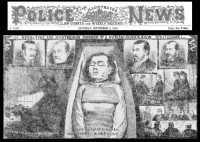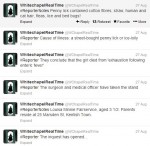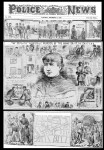 At 3:40 AM on Friday, August 31st, 1888, the mutilated body of Mary Ann Nichols was discovered on Buck’s Row in the Whitechapel district of London’s East End. Four more women would be found with their throats slit and bodies butchered in increasingly horrific manner between then and November 9th, a period that became known as the Autumn of Terror. The London Metropolitan Police Service’s Whitechapel Murders investigation covered the murders of 11 women killed from April 3rd, 1888, to February 13th, 1891, but the murders of Mary Ann Nichols, Annie Chapman, Elizabeth Stride, Catherine Eddowes, Mary Jane Kelly that fall would go down in history as the canonical victims of Jack the Ripper.
At 3:40 AM on Friday, August 31st, 1888, the mutilated body of Mary Ann Nichols was discovered on Buck’s Row in the Whitechapel district of London’s East End. Four more women would be found with their throats slit and bodies butchered in increasingly horrific manner between then and November 9th, a period that became known as the Autumn of Terror. The London Metropolitan Police Service’s Whitechapel Murders investigation covered the murders of 11 women killed from April 3rd, 1888, to February 13th, 1891, but the murders of Mary Ann Nichols, Annie Chapman, Elizabeth Stride, Catherine Eddowes, Mary Jane Kelly that fall would go down in history as the canonical victims of Jack the Ripper.
In honor of the 125th anniversary of the discovery of Mary Ann Nichols’ body that kicked off the Autumn of Terror, The History Press will be bringing the Whitechapel of 1888 to Twitter so we can experience in real time on social media what London residents experienced with the Ripper-mad press. The four-month project, Whitechapel Real Time, kicked off on August 24th with tweets about life, death and society in the East End.
 The sensationalized and often wildly inaccurate stories in the press are part of the Twitter story too, but all the information in the tweets has been researched thoroughly by historians to ensure its accuracy and to provide resources like period photographs, links to blog entries on the History Press website and genuine quotes from police, witnesses and neighbors. The people involved in the investigation of the Whitechapel murders have their own hashtags, as do reporters and locals commenting on events.
The sensationalized and often wildly inaccurate stories in the press are part of the Twitter story too, but all the information in the tweets has been researched thoroughly by historians to ensure its accuracy and to provide resources like period photographs, links to blog entries on the History Press website and genuine quotes from police, witnesses and neighbors. The people involved in the investigation of the Whitechapel murders have their own hashtags, as do reporters and locals commenting on events.
The idea is to break through the smog-and-oily-streets imagery that has come to symbolize the Whitechapel of 1888 and bring the time and place into focus by focusing on the people and issues that characterized it.
The mystery surrounding Jack the Ripper has been erroneously fuelled with images of darkened streets and figures in cloaks recounted by storytellers and portrayed in films and TV. The Whitechapel Real Time project seeks to peel back the myths and tell the ‘back story’ of the real people of Victorian London.
The aim of this project will challenge contemporary stereotypes and provoke debate on key issues such as social segregation and press sensationalism. Using today’s social media to tell the story mirrors the way in which the news ‘spreads like wildfire’ across London and throughout the country in 1888.
 So far what I like the most about the tweets are the OldBaily Recaps which are like a combination carnival barker and police blotter, and a reporter’s updates on an inquest of Louisa Minnie Fairservice, who died at just 3 1/2 apparently of enteric fever caused by a tainted “street-bought penny lick or ice-lolly.”
So far what I like the most about the tweets are the OldBaily Recaps which are like a combination carnival barker and police blotter, and a reporter’s updates on an inquest of Louisa Minnie Fairservice, who died at just 3 1/2 apparently of enteric fever caused by a tainted “street-bought penny lick or ice-lolly.”
There has been some comment from the Twitter account of the murder of Martha Tabram earlier that month (August 7th, 1888). Martha was one of the 11 Whitechapel murder victims who some believe was an early Ripper killing. Most historians exclude her because although her murder was brutal — she was stabbed 39 times in the throat, chest, abdomen and genitals —  stabbing doesn’t fit the Ripper modus operandi of slashed throats and disembowelment that would be established with the five canonical murders. When all of this was a developing story, however, any prostitute murdered in Whitechapel was linked by the press and the police.
stabbing doesn’t fit the Ripper modus operandi of slashed throats and disembowelment that would be established with the five canonical murders. When all of this was a developing story, however, any prostitute murdered in Whitechapel was linked by the press and the police.
Some of the tweets are a little obvious — particularly the comments about class made by hashtagged “Dockworker” and “WorkingLady” et al — but I’m hoping that’s just them getting their bearings. Keep your eye on Whitechapel Real Time once the Autumn of Terror kicks in for real on Saturday.
:skull:
This is a great thing. It’s why god let us create twitter – well, this and Drunk Hulk.
Hallowed be his name.
I agree with Bort. A truly great project.
The Ripper goes viral in new media just like he did in the old media.
A great idea to merge old history with modern day technology!